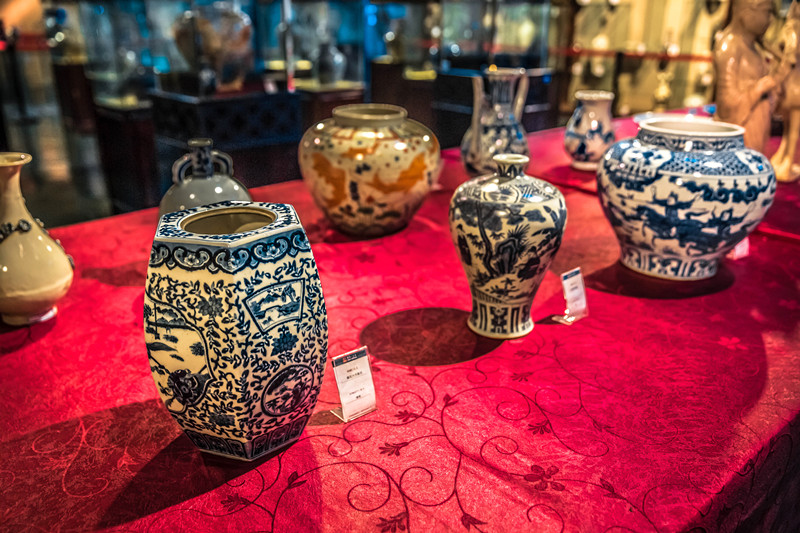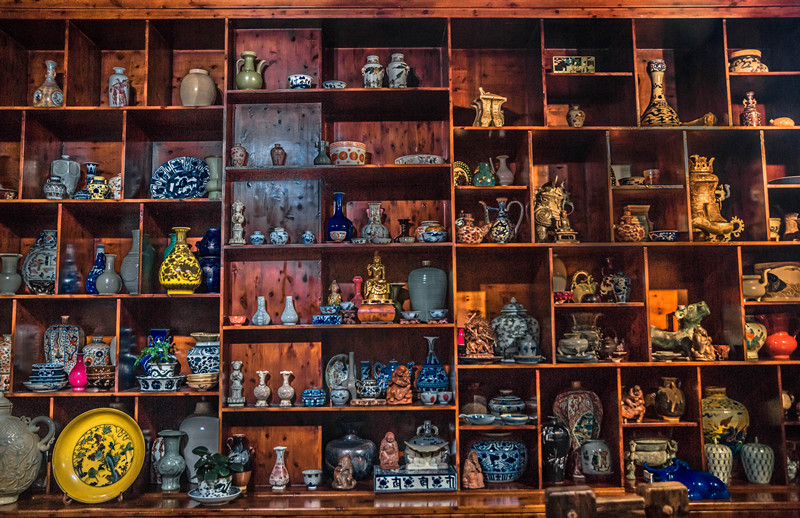瓷器是一种由瓷石、高岭土、石英石、莫来石等组成,外表施有玻璃质釉或彩绘的物器。瓷器的成形要通过在窑内经过高温烧制,瓷器表面的釉色会因为温度的不同从而发生各种化学变化。

中国是瓷器的故乡,瓷器是汉族劳动人民的一个重要的创造。瓷器的发明是汉民族对世界文明的伟大贡献,在英文中瓷器与中国(China)同为一词,充分说明中国瓷器的精美绝伦完全可以作为中国的代表。大约在公元前16世纪的商代中期,中国就出现了早期的瓷器。因为其无论在胎体上,还是在釉层的烧制工艺上都尚显粗糙,烧制温度也较低,表现出原始性和过渡性,所以一般称其为“原始瓷”。

中国瓷器是从陶器发展演变而成的,原始瓷器起源于3000多年前。至宋代时,名瓷名窑已遍及大半个中国,是瓷业最为繁荣的时期。当时的汝窑、官窑、哥窑、钧窑和定窑并称为宋代五大名窑,当时比较有名的还有柴窑和建窑。被称为瓷都的江西景德镇在元代出产的青花瓷已成为瓷器的代表。青花瓷釉质透明如水,胎体质薄轻巧,洁白的瓷体上敷以蓝色纹饰,素雅清新,充满生机。青花瓷一经出现便风靡一时,成为景德镇的传统名瓷之冠。与青花瓷共同并称四大名瓷的还有青花玲珑瓷、粉彩瓷和颜色釉瓷。另外,还有雕塑瓷、薄胎瓷、五彩胎瓷等,均精美非常,各有特色。
多姿多彩的瓷器是中国古代的伟大发明之一,高级瓷器拥有远高于一般瓷器的制作工艺难度,因此在古代皇室中也不乏精美瓷器的收藏。作为古代中国的特产奢侈品之一,瓷器通过各种贸易渠道传到各个国家,精美的古代瓷器作为具有收藏价值的古董。
元明清时期瓷器、宋朝瓷器、唐五代时期瓷器、六朝时期瓷器、原始青瓷、晚清民国瓷器;陈设器、文房用具、冥器、日用器;彩装饰、釉装饰、胎装饰;人物图案、动物图案、植物图案、山水图案、吉祥图案等各类瓷器本馆均有收藏。相对完整的体现了中国瓷器的学术体系与艺术发展脉络,以餮观者。
Tianyi Porcelain Museum
Porcelain is ceramic wares formed by porcelain stone, kaolin, quartz, mullite and etc., with glassy glaze or colored drawing covered on its surface. It can only be made by high temperature in kiln and its glaze will have variations because of high temperature.
China is the birthplace of porcelain, an important creation made by the Han Chinese . The invention of porcelain marks a great contribution to the world. That porcelain shares the same word with China in English, means the marvelous Chinese porcelain is a perfect representation for China. In the 16 century, the middle of Shang dynasty, the Chinese people invented porcelains. However, their bodies and glaze layers are clumsy; besides, they were also made in a relatively low temperature. As a result, the making process of porcelain was primitive and transitional and therefore they are called “primitive porcelain”.
The Chinese porcelain is evolved from pottery. Primitive porcelain originated in 3000 years ago. The porcelain industry is super-flourishing in the Song Dynasty when famous porcelains and kilns can be found in most Chinese cities at that time. Among those renown kilns, Ru kiln, Guan kiln, Ge kiln, Jun kiln and Ding kiln are most famous and then Chai and Jian kilns famous, too. Blue-and-white porcelain was invented in the Yuan Dynasty at Jingdezhen, a town known as the capital of porcelains. Its enamel is as clear as water and its body so gentle and thin. Covered with blue patterns, its white body is permeating the sense of elegance and freshness. The popularity of blue-white porcelain makes it top other porcelain. Together with the blue-and-white porcelain, blue-and-white exquisite porcelain, pastel porcelain and colored glaze porcelain are the four great ones. Besides, sculpture porcelain, thin bodied porcelain and colorful bodied porcelain also have their characteristics.
Various porcelains is one of the great inventions in ancient China. The exquisite porcelains’ making processes is far difficult than the singular ones. So, exquisite porcelains were usually collected by royal families. As one of the special luxuries in ancient China, porcelains were exported to other countries through different trade channels for their value of collection.
In this museum, there are porcelains from the primitive society to the period of the Republic of China; devices for display, funeral and daily usage, as well as stationery appliances; colorful decoration, glazing decoration and body decoration; patterns of figure, animal, plant, mountain, river and fortune. All collections will better visitor’s understanding and appreciation of how theacademic and artistic system of Chinese porcelains develops.




